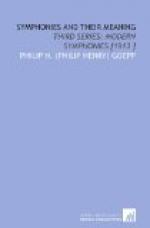“According to a legend, the combatants were so exasperated that the slain rose during the night and fought in the air. Rome, which is seen in the background, is said to have been the scene of this event. Above, borne on a shield, is Attila, with a scourge in his hand; opposite him Theodoric, King of the Visigoths. The foreground is a battle-field, strewn with corpses, which are seen to be gradually reviving, rising up and rallying, while among them wander wailing and lamenting women.”]
The evidence of the composer’s intent is embodied in a letter written in 1857 to the wife of the painter, which accompanied the manuscript of an arrangement of the music for two pianos. In the letter Liszt speaks of “the meteoric and solar light which I have borrowed from the painting, and which at the Finale I have formed into one whole by the gradual working up of the Catholic choral ‘Crux fidelis,’ and the meteoric sparks blended therewith.” He continues: “As I have already intimated to Kaulbach, in Munich, I was led by the musical demands of the material to give proportionately more place to the solar light of Christianity, personified in the Catholic choral ... than appears to be the case in the glorious painting, in order to win and pregnantly represent the conclusion of the Victory of the Cross, with which I both as a Catholic and as a man could not dispense.”
The work begins tempestuoso (allegro non troppo), with a nervous theme over soft rolling drums and
[Music: Tempestuoso. Allegro non troppo (Bassoons with tremolo cellos and roll of kettle-drums)]
trembling low strings, that is taken up as in fugue by successive groups and carried to a height where enters a fierce call of the horns. The cries of battle spread with increasing din and gathering speed. At the first climax the whole motion has a new energy, as the strings in feverish chase attack the quickened motive with violent stress. Later, though the motion has not lessened, the theme has returned to a semblance of its former pace, and again the cries of battle (in brass and wood) sound across its path.
[Music: (Strings, tremolo, doubled above) (Horns)]
In the hush of the storm the full-blown call to arms is heard in lowest, funereal tones. Of a sudden, though the speed is the same, the pace changes with a certain terror as of a cavalry attack. Presently amid the clattering tramp sounds the big hymn,—in the ancient rhythm that moves strangely out of the rut of even time.[A]
[Footnote A: Quoted on the following page.]
A single line of the hymn is followed by a refrain of the battle-call, and by the charge of horse that brings back the hymn, in high pitch of trumpets. And so recur the former phases of battle,—really of threat and preparation. For now begins the serious fray in one long gathering of speed and power. The first theme here grows to full melodic song, with extended answer, led by strepitous band of lower reed over a heavy clatter of strings. We are in a




